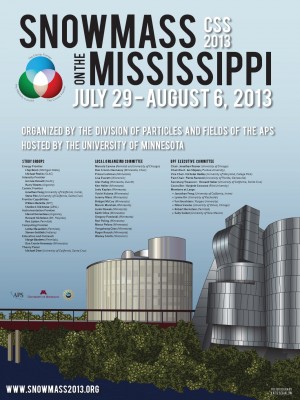
The US particle physics strategy “Snowmass process” will culminate in the ‘Snowmass on the Mississippi’ workshop from 29 July to 6 August, in Minneapolis. Image: Katie Schalow.
For the realisation of a linear collider, a significant contribution from the United States is essential. A critical step is that the project is positively included in the US strategy for high-energy physics.
The formation of the US strategy is currently in progress through a multi-step process. First, the High Energy Physics Advisory Panel (HEPAP) facility subpanel has reviewed large projects costing more than 100 million dollars that could start within the next ten years (“CD1 approval” to be precise). HEPAP gave the ILC a high mark, but this was just a start. A long community planning process – the so-called Snowmass process – is in progress with some fifteen workshops culminating in the Snowmass on the Mississippi workshop, from 29 July to 6 August, in Minneapolis. A meeting of the American Physical Society Division of Particles and Fields (DPF 2013) will then be held in the following week, and findings from the Snowmass process will be presented there. The final report will be released at the end of September.
Taking the outcome of the Snowmass process as an input, the HEPAP particle physics project prioritisation panel (called “P5”) will aim at forming a strategic plan that is feasible and executable over a 10-to-20-year timescale. Such a process was last happening in 2008, and it was one of the key inputs to the agencies in deciding the US strategy for high-energy physics. The P5 deliberations are expected to be interleaved with town meetings where further inputs from the community will be made.
The outcome of the Snowmass process is being watched attentively from outside of the US as well. When a group of Japanese Diet members wrote a letter to solicit US participation in the ILC if it is hosted by Japan, William Brinkman, at the time Head of DOE’s of Office of science, replied “Once these studies and the community inputs are complete, we will be in a better position to evaluate future US priorities for the HEP programme”, referring to the Snowmass and P5 process. The Japanese government very well recognises the importance of the process.
As the European strategy for particle physics update document clearly states, “there is a strong scientific case for an electron-positron collider, complementary to the LHC, that can study the properties of the Higgs boson and other particles with unprecedented precision and who energy can be upgraded.” According to the current timelines, the ILC would run in parallel with the high-luminosity upgrade of the LHC (HL-LHC) and would provide precision measurements of the Higgs particles. One should note, however, that the precision numbers themselves are not enough to tell the power of the ILC. The experimental and theoretical cleanliness and abilities to control the initial state and even the intermediate states of electron-positron interaction would elucidate delicate effects that might signify new physics.
The specifications of the ILC Technical Design Report are conservative ones, and very significant increases in luminosity are feasible by increasing the power consumption of the ILC within a reasonable range. The ILC has the flexibility to increase energy up to somewhat beyond one TeV to study any particle or phenomenon that the LHC might find in this energy range in the coming decades. It also has the sensitivity that may allow us to discover new phenomena that would be impossible to detect at the LHC. The LHC is learning rapidly while dealing with the real data and a linear collider will certainly follow a learning curve as well. As a result, expected precisions would improve for both machines over current projections. It would be a great picture to see two fantastic machines in operation, keeping active the field of high-energy physics and also of science in general, stimulating young minds from around the world.
The Snowmass workshops are open and researchers from outside of North America are encouraged to attend. This makes particular sense since the direction of the US high-energy physics choices will have global implications. The US has always been a driving force in the design of both the ILC machine and detectors; many of us from outside the US who will attend the Snowmass meetings as guests look forward to interesting discussions and to learning how the US can continue this leading role in the future.


Recent Comments